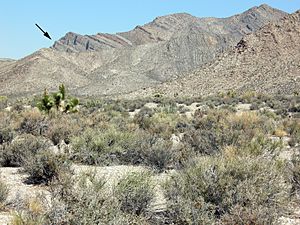Alamo bolide impact facts for kids
The Alamo bolide impact happened a very long time ago, about 377 to 378 million years ago. This was when one or more giant space rocks, called "bolides," crashed into shallow ocean waters. This powerful crash happened in an area that is now southeastern Nevada. The event is named after special crushed rock deposits, called "breccia," found near the town of Alamo, Nevada. These rock deposits are known as the "Alamo Breccia."
This amazing impact is one of the best-studied and most accurately dated impact events on Earth. It happened during a time period called the Devonian period. This was about 5.9 million years before a major extinction event, so it's unlikely the Alamo impact caused that extinction.
Contents
What Was the Alamo Bolide Impact?
The Alamo bolide impact was a massive collision between a space object and Earth. It happened when Nevada was covered by a shallow sea. The impact created a huge amount of shattered rock and changed the landscape forever.
Where Did It Happen?
The exact spot where the bolide hit is still being studied. Scientists aren't completely sure about its exact size or shape because the area has changed a lot over millions of years. Earth's movements, like thrust faults, have squeezed and shifted the rocks. This makes it hard to figure out exactly what the area looked like right after the impact.
We do know that the impact happened in a "wet-target" area. This means it hit a shallow ocean where carbonates (like limestone) were forming in coral reefs.
What Did the Impact Leave Behind?
The impact site is filled with huge blocks of displaced rock, known as "megabreccia." Scientists have also found other clues that point to a space impact:
- Shocked quartz: These are tiny pieces of the mineral quartz that have been changed by extreme pressure from an impact.
- Elevated iridium levels: Iridium is a rare metal on Earth's surface but is more common in space objects like asteroids. Finding higher levels of iridium can be a sign of an impact.
- Spherical lapilli: These are small, round beads of rock that form when molten material from an impact cools quickly.
John E. Warme, one of the first geologists to realize this was an impact site, believes that about 1,000 cubic kilometers of rock and reef deposits were crushed, melted, or moved by the Alamo event. He also noted that huge tsunamis (giant ocean waves) followed the impact, moving much of the debris around.
How Was It Discovered?
The idea that the Alamo Breccia was caused by a bolide impact wasn't immediately accepted by everyone. However, the first scientific paper about it was published in 1993. It was written by John Warme and his colleagues Brian Ackman, Yarmanto, and Alan Chamberlain. Their work helped explain the strange rock formations in Nevada as the result of a powerful space collision.



